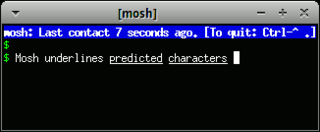Related Research Articles
The Secure Shell Protocol (SSH) is a cryptographic network protocol for operating network services securely over an unsecured network. Its most notable applications are remote login and command-line execution.

Network address translation (NAT) is a method of mapping an IP address space into another by modifying network address information in the IP header of packets while they are in transit across a traffic routing device. The technique was originally used to bypass the need to assign a new address to every host when a network was moved, or when the upstream Internet service provider was replaced, but could not route the network's address space. It has become a popular and essential tool in conserving global address space in the face of IPv4 address exhaustion. One Internet-routable IP address of a NAT gateway can be used for an entire private network.
The File Transfer Protocol (FTP) is a standard communication protocol used for the transfer of computer files from a server to a client on a computer network. FTP is built on a client–server model architecture using separate control and data connections between the client and the server. FTP users may authenticate themselves with a plain-text sign-in protocol, normally in the form of a username and password, but can connect anonymously if the server is configured to allow it. For secure transmission that protects the username and password, and encrypts the content, FTP is often secured with SSL/TLS (FTPS) or replaced with SSH File Transfer Protocol (SFTP).
A virtual private network (VPN) is a mechanism for creating a secure connection between a computing device and a computer network, or between two networks, using an insecure communication medium such as the public Internet.
SOCKS is an Internet protocol that exchanges network packets between a client and server through a proxy server. SOCKS5 optionally provides authentication so only authorized users may access a server. Practically, a SOCKS server proxies TCP connections to an arbitrary IP address, and provides a means for UDP packets to be forwarded. A SOCKS server accepts incoming client connection on TCP port 1080, as defined in RFC 1928.
In computer networking, Layer 2 Tunneling Protocol (L2TP) is a tunneling protocol used to support virtual private networks (VPNs) or as part of the delivery of services by ISPs. It uses encryption ('hiding') only for its own control messages, and does not provide any encryption or confidentiality of content by itself. Rather, it provides a tunnel for Layer 2, and the tunnel itself may be passed over a Layer 3 encryption protocol such as IPsec.

A shell account is a user account on a remote server, typically running under Unix or Linux operating systems. The account gives access to a text-based command-line interface in a shell, via a terminal emulator. The user typically communicates with the server via the SSH protocol. In the early days of the Internet, one would connect using a modem.

In computer networking, port forwarding or port mapping is an application of network address translation (NAT) that redirects a communication request from one address and port number combination to another while the packets are traversing a network gateway, such as a router or firewall. This technique is most commonly used to make services on a host residing on a protected or masqueraded (internal) network available to hosts on the opposite side of the gateway, by remapping the destination IP address and port number of the communication to an internal host.
OpenVPN is a virtual private network (VPN) system that implements techniques to create secure point-to-point or site-to-site connections in routed or bridged configurations and remote access facilities. It implements both client and server applications.
In computer networking, port knocking is a method of externally opening ports on a firewall by generating a connection attempt on a set of prespecified closed ports. Once a correct sequence of connection attempts is received, the firewall rules are dynamically modified to allow the host which sent the connection attempts to connect over specific port(s). A variant called single packet authorization (SPA) exists, where only a single "knock" is needed, consisting of an encrypted packet.
An application firewall is a form of firewall that controls input/output or system calls of an application or service. It operates by monitoring and blocking communications based on a configured policy, generally with predefined rule sets to choose from. The two primary categories of application firewalls are network-based and host-based.
In computer networks, a tunneling protocol is a communication protocol which allows for the movement of data from one network to another. It can, for example, allow private network communications to be sent across a public network, or for one network protocol to be carried over an incompatible network, through a process called encapsulation.

A terminal server connects devices with a serial port to a local area network (LAN). Products marketed as terminal servers can be very simple devices that do not offer any security functionality, such as data encryption and user authentication. The primary application scenario is to enable serial devices to access network server applications, or vice versa, where security of the data on the LAN is not generally an issue. There are also many terminal servers on the market that have highly advanced security functionality to ensure that only qualified personnel can access various servers and that any data that is transmitted across the LAN, or over the Internet, is encrypted. Usually, companies that need a terminal server with these advanced functions want to remotely control, monitor, diagnose and troubleshoot equipment over a telecommunications network.
In computer networking, TUN and TAP are kernel virtual network devices. Being network devices supported entirely in software, they differ from ordinary network devices which are backed by physical network adapters.
The Internet Adapter (TIA) was software created by Cyberspace Development in 1993 to allow Serial Line Internet Protocol (SLIP) connections over a shell account. Point-to-Point Protocol (PPP) was added in 1995, by which time the software was marketed and sold by Intermind of Seattle. Shell accounts normally only allow the use of command line or text-based software, but by logging into a shell account and starting the TIA daemon, a user could then run any TCP/IP-based application, including standard GUI software such as the then-popular Netscape Navigator on their computer. This was especially useful at the time because simple shell accounts were much less expensive than full SLIP/PPP accounts. TIA was ported to a large number of unix or unix-like systems.
Web-based SSH is the provision of Secure Shell (SSH) access through a web browser. SSH is a secure network protocol that is commonly used to remotely control servers, network devices, and other devices. With web-based SSH, users can access and manage these devices using a standard web browser, without the need to install any additional software.
TCP Gender Changer is a method in computer networking for making an internal TCP/IP based network server accessible beyond its protective firewall.

OpenSSH is a suite of secure networking utilities based on the Secure Shell (SSH) protocol, which provides a secure channel over an unsecured network in a client–server architecture.

In computing, Mosh is a tool used to connect from a client computer to a server over the Internet, to run a remote terminal. Mosh is similar to SSH, with additional features meant to improve usability for mobile users. The major features are:

SoftEther VPN is free open-source, cross-platform, multi-protocol VPN client and VPN server software, developed as part of Daiyuu Nobori's master's thesis research at the University of Tsukuba. VPN protocols such as SSL VPN, L2TP/IPsec, OpenVPN, and Microsoft Secure Socket Tunneling Protocol are provided in a single VPN server. It was released using the GPLv2 license on January 4, 2014. The license was switched to Apache License 2.0 on January 21, 2019.
References
- ↑ Rideau, François-René (2001), Firewall Piercing mini-HOWTO, Secure solution: piercing using ssh
- ↑ JDIMPSON (2008), pppsshslirp: create a PPP session through SSH to a remote machine to which you don't have root
- ↑ Jim Knoble (1996-08-01). "Almost Internet with SLiRP and PPP". Linux Journal . Retrieved 2009-08-28.
- ↑ Craig J. Miller (1995-03-15). "Intermind discussion of TIA on TENET" . Retrieved 2009-08-31.
- ↑ "Everybody's Internet Update (section 1.5)". Electronic Frontier Foundation. September 1994. Retrieved 2009-08-31.
- ↑ Kelly Price. "Slirp Maintenance Project home page" . Retrieved 2009-08-31.
- 1 2 Glen Reesor (2001-02-21). "SLIP/PPP Emulator mini-HOWTO" . Retrieved 2009-08-29.
- ↑ Kelly Price. "Slirp FAQ" . Retrieved 2009-08-28.
- ↑ "Debian Changelog slirp" . Retrieved 2009-08-28.
- ↑ "Releases - rootless-containers/slirp4netns". 2019-01-04.
- ↑ "[Qemu-devel] Remove the advertising clause from the slirp license".
- ↑ "[Qemu-devel] Re: slirp-related crash".